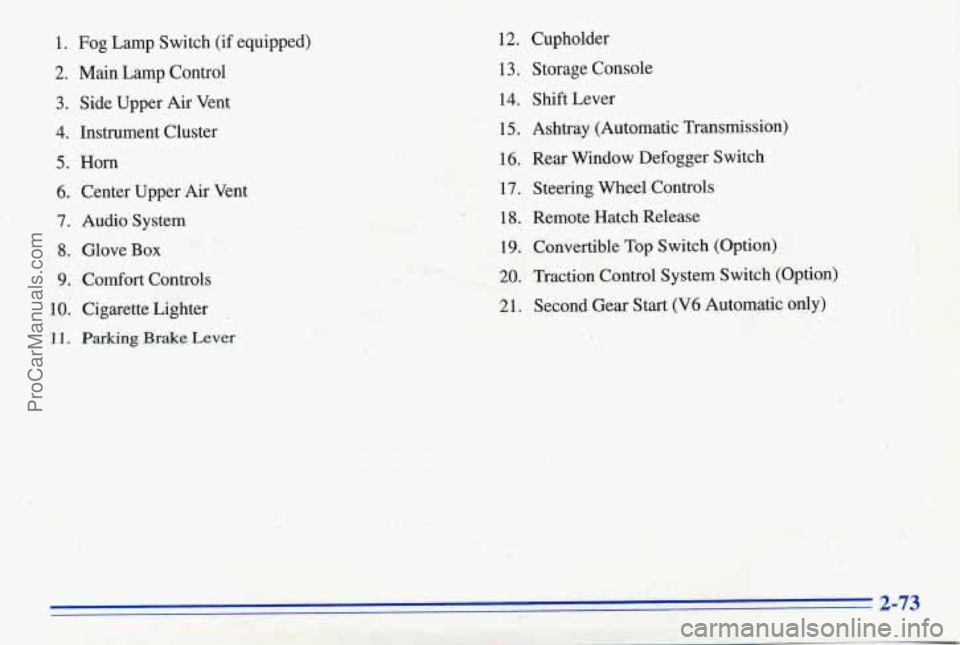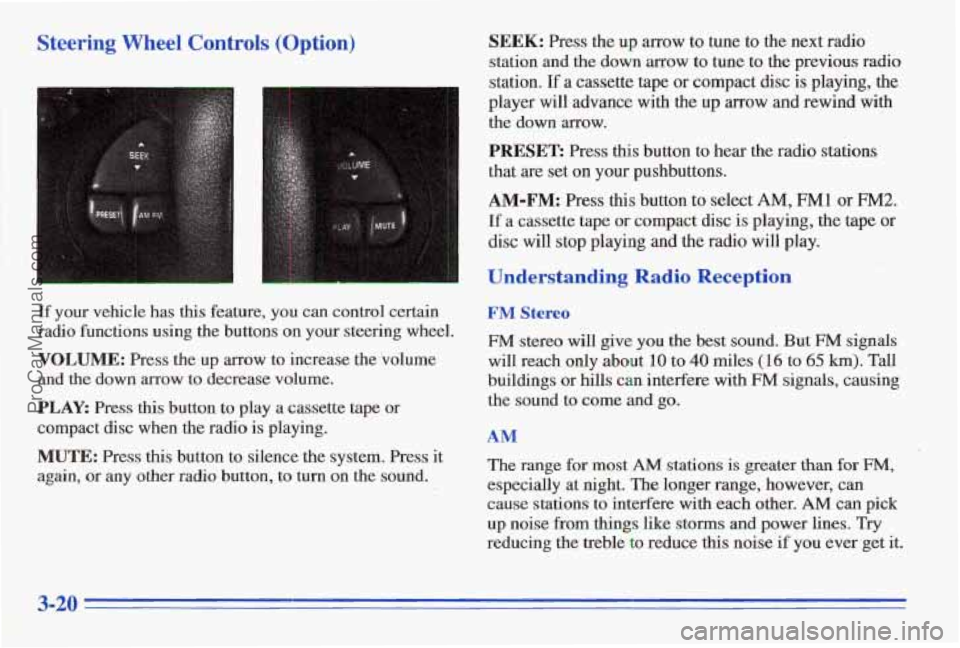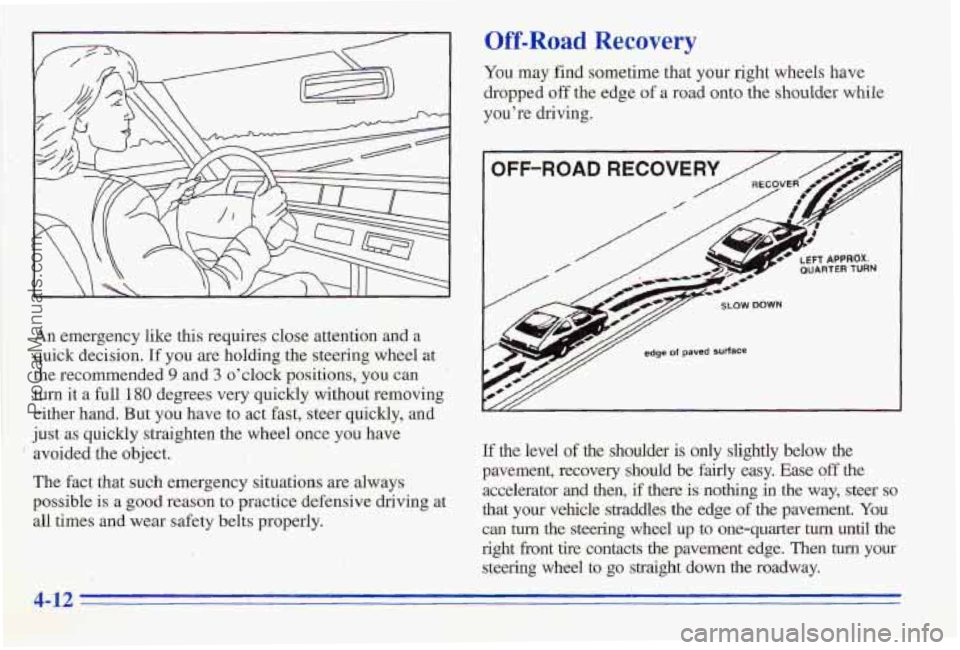steering PONTIAC FIREBIRD 1996 User Guide
[x] Cancel search | Manufacturer: PONTIAC, Model Year: 1996, Model line: FIREBIRD, Model: PONTIAC FIREBIRD 1996Pages: 386, PDF Size: 19.18 MB
Page 122 of 386

1. Fog Lamp Switch (if equipped)
2. Main Lamp Control
3. Side Upper Air Vent
4. Instrument Cluster
5. Horn
6. Center Upper Air Vent
7.
Audio System
8. Glove Box
9. Comfort Controls
10. Cigarette Lighter .
1 1. Parking Brake Lever
12. Cupholder
13. Storage Console
14. Shift Lever
15. Ashtray (Automatic Transmission)
16. Rear Window Defogger Switch
17. Steering Wheel Controls
18. Remote Hatch Release
19. Convertible Top Switch (Option)
20. Traction Control System Switch (Option)
21. Second Gear Start (V6 Automatic only)
2-73
ProCarManuals.com
Page 157 of 386

Steering Wheel Controls (Option)
If your vehicle has this feature, you can control certain
radio functions using the buttons on
your steering wheel.
VOLUME: Press the up arrow to increase the volume
and the down arrow to decrease volume.
PLAY: Press this button to play a cassette tape or
compact disc when the radio is playing.
MUTE: Press this button to silence the system. Press it
again, or any other
radio button, to turn on the sound.
SEEK: Press the up mow to tune to the next radio
station and
the down arrow to tune to the previous radio
station. If a cassette tape or compact disc is playing, the
player will advance with the up arrow and rewind with
the down mow.
PRESET: Press this button to hear the radio stations
that
are set on your pushbuttons.
AM-F": Press this button to select AM, FM1 or €342.
If a cassette tape or compact disc is playing, the tape or
disc will stop playing and the radio will play.
UBderstanding Radio R: 3eption
FM Stereo
FM stereo will give you the best sound. But FM signals
will reach only about
10 to 40 miles ( 16 to 65 km). Tall
buildings or
hills can interfere with FM signals, causing
the sound to come and go.
AM
The range for most AM stations is greater than for FM,
especially at night. The longer range, however, can
cause stations
to interfere with each other. AM can pick
up noise horn things like storms and power lines. Try
reducing the treble to reduce this noise if you ever get it.
ProCarManuals.com
Page 166 of 386

Control of a Vehicle Braking
You
have three systems that make your vehicle go where Braking action involves perception time and
you want it to go. They are the brakes, the steering and reaction time.
the accelerator. All three systems have to do their work
First, you have to decide to push on the brake pedal.
at the places where the tires meet the road.
That’s perception time. Then you have to bring up
your fo.ot and do
it. That’s reaction time.
Average reaction time
is about 314 of a second. But
that’s only an average. It might be less with
one driver
and as long as two or three seconds or more with
another. Age, physical condition, alertness, coordination
and eyesight all play a part.
So do alcohol, drugs and
frustration. But even
in 3/4 of a second, a vehicle
moving at
60 mph (100 km/h) travels 66 feet (20 m).
That could be a lot
of distance in an emergency, so
keeping enough space between your vehicle and others
is important.
And, of course, actual stopping distances vary greatly
with the surface
of the road (whether it’s pavement or
gravel); the condition of the road (wet, dry, icy); tire
tread; and the condition
of your brakes.
Sometimes, as when you’re driving on snow or ice, it’s
easy
to ask more of those control systems than the tires
and road can provide. That means you can lose control
of your vehicle.
4-5
ProCarManuals.com
Page 171 of 386

. If the traction control system is limiting wheel spin
when you press the button, the light on the button will
.go off and the warning light will come on -- but the
_. ._ ,system won't turn off right away. It will wait until
gathere's
no longer a current need to limit wheel spin. I
You can turn the system back an at any time by pressing
the button
again. The light on the button should come
on, and the traction control system w'arning light should
go off.
If your car is equipped with P245/50zR16 tires, the
traction control system will automatically
turn off at
speeds above 108 mph (1 74 km/h). (The traction, control
system waning light will not corn on.) When the
vehicle
speed drops below 103 mph (1 66 km/h) the
system will automatically come on again.
- Braking in Emergencies
Use your anti-lock braking system when you need to.
With anti-lock, you can steer and brake at the same
time. In many emergencies, steering can help you more
than even
the very best braking.
Steering
Power Steering
If you lose power steering assist because the engine
stops or the system
is not functioning, you can steer but
it will take much
more effort.
Steering Tips
Driving on Curves
It's important to take curves at a reasonable speed.
A lot of the "driver lost control" accidents mentioned on
the news happen on curves. Here's why:
Experienced driver or beginner, each of us
is subject to
the same laws
of physics when driving on curves. The
traction
of the tires against the road surface makes it
possible for the vehicle to change its path when you turn
the front wheels. If there's no traction, inertia will keep
the vehicle going in the same direction. If you've ever
tried to steer a vehicle on wet ice, you'll understand
this.
i ., _. .I ..
ProCarManuals.com
Page 172 of 386

I
.-.
The traction you can get in a curve depends on the
condition
of your tires and the road surface, the angle at
which the curve is banked, and your speed.
While you’re
in a curve, speed is the one factor you can control.
Suppose’ you’re steering through a sharp curve. Then you
suddenly accelerate. Both control systems -- steering
and acceleration
-- have to do their work where the tires
meet the road. Unless you have traction control and the
system is on, adding the sudden acceleration can demand
too much of
those places. You can lose control.
What should you do if.this ever happens? Ease up
on the
accelerator pedal, steer the vehicle the way you want
it
to go, and slow down.
Speed limit signs near curves warn that you should
adjust your speed. Of courqe, the posted speeds are
based on good weather and road conditions. Under less
favorable conditions you’ll want
to go slower.
Try to adjust your speed so you can “drive” through the
curve. Maintain a reasonable, steady speed. Wait to
accelerate until
you are out of the curve, and then
accelerate gently into the straightaway.
Steering in Emergencies
There are times when steering can be more effective
than braking. For example,
you come over a hill and
find a truck stopped in your lane, or a car suddenly pulls
out from nowhere, or a child darts out from between
parked cars and stops right in front of you. You can
avoid these problems by braking
-- if you can stop in
time. But sometimes you can’t; there isn’t room.
That’s the time for evasive action
-- steering around
the problem.
Your Pontiac can perform very well in emergencies like
these. First apply your brakes. (See “Braking in
Emergencies” earlier in
this section.) It is better to
remove as much speed as you can from a possible
collision. Then steer around the problem,
to the left or
right depending on the space available,
u ’ ..**vu-.. UY . .. . --
ProCarManuals.com
Page 173 of 386

An emergency like this requires close attention and a
quick decision. If you are holding
the steering wheel at
the recommended
9 and 3 o’clock positions, you can
turn it a full 180 degrees very quickly without removing
either hand. But you have to act fast, steer
quickly, and
just
as quickly straighten the wheel once you’have
’ avoided the object,
The fact
that such emergency situations are always
possible
is a good reason to practice defensive driving at
all times and wear safety belts properly.
Off-Road Recovery
YOU may find sometime that your right wheels have
dropped
off the edge of a road onto the shoulder while
you’re driving.
If the level of the shoulder is only slightly below the
pavement, recovery should be fairly easy. Ease
off the
accelerator and then, if there
is nothing in the way, steer so
that your vehicle straddles the edge of the pavement. You
can turn the steering wheel up to one-quarter turn until the
right front
tire contacts the pavement edge. Then tum your
steering wheel to
go straight down the roadway.
4-12
ProCarManuals.com
Page 175 of 386

0
0
0
0
Check your mirrors, glance over your shoulder, and
start your left lane change signal before moving out
of the right lane to pass. When you are far enough
ahead of the passed vehicle to see its front in your
inside mirror, activate your right
lane change signal
and move back into the right lane. (Remember that
your right outside mirror
is convex. The vehicle you
just passed may seem to be farther away from you
than
L it really is,)
Try not to pass more than one vehicle at a time
on two-lane roads. Reconsider before passing the
next vehicle.
Don’t
overtake a slowly moving vehicle too rapidly.
Even though the brake lamps
are not flashing,,it may
be slowing down or starting to turn.
If you’re being passed, make it easy for the
following driver to get ahead
of you. Perhaps you
can ease a little to the right.
Loss of Control
Skidding
In a skid, a driver can lose control of the vehicle.
Defensive drivers avoid
most skids by taking reasonable
care suited to existing conditions, and by not “overdriving”\
those conditions. But skids
are always possible.
The three types of skids correspond
to your Pontiac’s
three control systems. In the braking
skid, your wheels
aren’t rolling. In the steering or cornering skid, too
much speed or steering in a curve causes tires to slip and
lose cornering force. And in the acceleration skid, too
much throttle causes the driving wheels
to spin.
A cornering skid is best handled by easing your foot off
the accelerator pedal.
If you have the traction control system, remember: It
helps avoid only the acceleration skid.
If
you do not have traction control, or if the system is
off, then an acceleration skid is also best handled by
easing your foot off the accelerator pedal.
Let’s
review what driving experts say about what E your vehicle starts to slide, ease your foot off the
happens when the
three control systems (brakes, steering accelerator
pedal and quickly steer the way you want the
and acceleration) don’t have enough friction where the vehicle to
go. If you start steering quickly enough, your
tires meet the road to do what the driver has asked. vehicle may straighten
out. Always be ready for a
constantly seek an escape route or area of less danger. second
skid if it occurs.
. .-
. -- . r- _.. In any emergency, don’t give up. Keep trying to steer and ..
ProCarManuals.com
Page 176 of 386

Of course, traction is reduced when water, snow, ice,
gravel or other material is on the road.
For safety, you’ll
want
to slow down and adjust your driving to these
conditions.
It is important to slow down on slippery
surfaces because stopping distance will
be longer and
vehicle control more limited.
While driving on
a surface with reduced traction, try your
best to avoid sudden steering, acceleration or braking
(including engine braking by shifting to a lower gear).
Any sudden changes could cause the tires
to slide. You
may not realize the surface is slippery until your vehicle
is skidding. Learn to recognize warning clues
-- such as
enough water, ice or packed snow on the road to make a
“mirrored surface”
-- and slow down when you have
any doubt.
Remember: Any anti-lock brake system (ABS) helps
avoid only the braking slud.
Driving at Night
Night driving is more dangerous than day driving. One
reason is that some drivers are likely to
be impaired -- by
alcohol or
drugs, with night vision problems, or by fatigue.
4-15
ProCarManuals.com
Page 188 of 386

four anti-lock brakes improve your vehicle’s stability
when you make a hard stop on a slippery road. Even
though you have the anti-lock braking system, you’ll
want to begin stopping sooner than you would on dry
pavement. See “Anti-Lock” in the Index.
Allow greater following distance on apy slippery road.
Watch for slippery spots. The road might be fine
until you’hit
a spot that’s covered with ice. On an
otherwise clear road, ice patches may appear in
shaded areas where the sun can’t reach: around
clumps
of trees, behind buildings or under bridges.
Sometimes the surface
of a curve or anoverpass may
remain icy when the surrounding roads are clear.
If
you see a patch of ice ahead of you, brake before you
are on it.
Try not to brake while you’re actually on
the ice, and avoid sudden steering maneuvers.
If You’re Caught in a Blizzard
If you are stopped by heavy snow, you could be in a
serious situation. You.should probably stay with your
vehicle unless
you know for sure that you are near help
and you can hike through the snow. Here are some
things to do to summon help and keep yourself and
your
passengers safe:
4-27
ProCarManuals.com
Page 197 of 386

Driving with a m +er
Towing a trailer requires a certain amount of experience.
Before setting out for the
open road, you’ll want to get
to know your rig. Acquaint yourself with the feel of
handling and braking with the added weight of the
trailer. And always keep .in mind that the vehicle you are
driving is now a good deal longer and not nearly as
responsive as your vehicle
is by itself.
Before you start, check the trailer hitch and platform
(and attachments), safety chains, electrical connector,
lamps, tires and mirror adjustment. If the trailer has
electric brakes, start your vehicle
and trailer moving and
then apply the trailer brake controller by hand to be sure
the brakes are working. This lets you check your
electrical connection at the same time.
During your trip, check occasionally to be sure that the
load is secure, and that the lamps
and any trailer brakes
are still working.
FoIlowing Distance
Stay at least twice as far behind the vehicle ahead as you
would when driving your vehicle without a trailer. This
can help you avoid situations that require heavy braking
and sudden turns.
Passing
You’ll need more passing distance up ahead when
you’re towing a trailer. And, because you’re a good deal
longer,
you’ll need to go much farther beyond the
passed vehicle before
you can return to your lane.
Backing Up
Hold the bottom of the steering wheel with one hand.
Then, to move the trailer to the left, just move that hand
to the left. To move the trailer to the right, move your
hand to the right. Always back up slowly and,
if
possible, have someone guide you.
Making Turns
NOTICE:
Making very sharp turns while trailering could
cause the trailer to come
in contact with the
vehicle.
Your vehicle coul’d be damaged. Avoid
making very
sharp turns while trailering.
When you’re turning with a trailer, make wider turns than
normal. Do this so your trailer won’t strike soft shoulders,
curbs, road signs, trees or other objects. Avoid jerky or
sudden maneuvers. Signal well in advance.
4-36
ProCarManuals.com